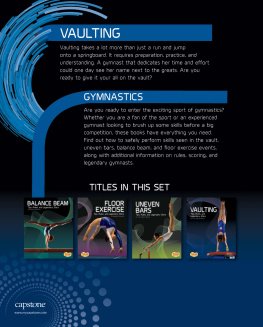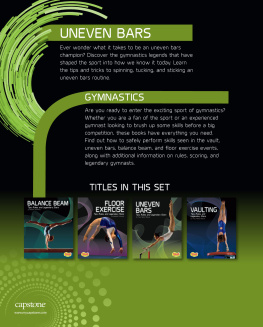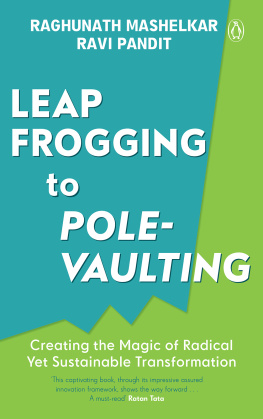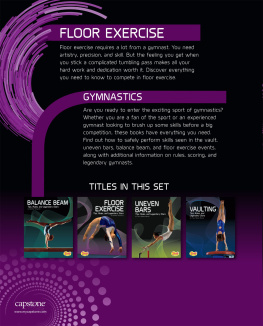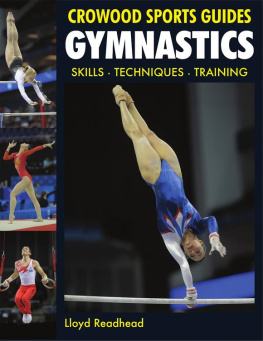Imagine a game of extreme leapfrog, and youre close to the thrill of the vault in gymnastics. To vault means to jump over something. Gymnasts use a helps these gymnasts get big airup to 8 feet (2.4 meters)for spectacular tricks.
Vaulting is an artistic gymnastics event. Some artistic gymnastic events are for only men or women. For example, only women compete in balance beam and uneven bars. Men compete in still rings, pommel horse, high bar, and parallel bars. But both genders compete in vault and floor exercise events.
Gymnasts perform the vault with one or more moves in a fast series while in the air. Dont blink! The entire vault is over in seconds. But it can take months to learn a new move and even longer to polish the entire vault from start to finish. The amazing vaults at the Olympics begin with countless hours of practice and exercises.
Fast Fact:
Ancient Romans used a wooden horse to teach mounts and dismounts. Gymnastics borrowed this idea for the early vault apparatus, but todays vaulting table replaced this apparatus in 2001.
CHAPTER 1
Ready, Set, Vault!
Vault practice should only be done at a gym or club with adult supervision. There, experienced coaches and the best equipment create a safe environment. In the United States, many clubs are affiliated with USA Gymnastics. Visit USA Gymnastics official website to find clubs near you.
Vaulting work means sweaty practices at the gymnastics gym. A coach or trainer needs to stand nearby as a every time you practice a vault. Spotters stay ready to protect a gymnast from a fall. Before you start doing skills on the block, you need to be prepared. And that includes showing up ready to work.
Gymnastics Garb
with short pants over it. Some wear short athletic shorts instead of pants over the singlet.
Table Talk
A vaulting table measures approximately 3.9 feet (120 centimeters) long by 3.1 feet (95 cm) wide for both men and women. The sloped front makes blocking safer for gymnasts. A padded surface absorbs shock to help avoid shoulder and wrist injuries. Women vault the table at approximately 4.1 feet high (125 cm). Men use it at 4.4 feet high (135 cm).
Preflight
Gymnasts practice running hard down the padded runway to gain . Their knees pump high and elbows stay close to the body.
Gymnasts also work on their instead of a hurdle on to the board. Once theyve landed the round off, they propel from the springboard toward the table using a back handspring.
The part of the vault from the springboard until the gymnasts hands reach the apparatus is called the . Any preflight trick, such as the back handspring, should position the gymnast for the block. Hands come to the table flat and shoulder-width apart. The rest of the body aligns with the shoulders. Elbows stay straight. Ankles stay together in the preflight while the hands are in contact with the table.

Fast Fact:
Men have competed in the vault at the Olympics since 1896. Women began competing individually in the event in 1952.
Postflight
From the block, the shows off the gymnasts skills high in the air. Greater height from the block allows more time for tricks with complex twists and flips.
Landing
The vault ends with the landing. To stick the landing, feet should sink into the mat no more than shoulder-width apart. Bent knees absorb the impact. Arms straight out with palms down help add balance and prevent wobbling. Any additional steps lose points from judges. The gymnast immediately strikes a final pose with legs straight, back arched, chin up, and arms high.
Train For Speed And Power
Vaulting requires speed and power. A typical workout includes warm-ups, apparatus practice, and conditioning. Some conditioning workouts are:
- chin-ups, pull-ups, and push-ups to increase arm strength
- sit ups and planks that work the core muscles for tight flips and controlled landings
- plyometric jumps, such as small jumps on a mini-trampoline that build power and explosiveness for hurdles
CHAPTER 2
Block Talk
Gymnasts strive for good form. They control every body movement so that their performances appear easy and graceful. They work on building powerful blocks and explosive launches from the table.

Fast Fact:
Gymnasts nicknamed the vaulting table the tongue for its curvy shape.
Judges watch the height or deduct points. How do gymnasts improve amplitude and distance? Practice, practice, practice!
An experienced vault coach moves each gymnast step by step from basic skills toward difficult tricks. Skipping ahead to a harder trick before youre ready could stunt your confidence and, worse, cause injuries.
Fall Right
Every gymnast falls countless times when learning new skills. The trick is to fall safely. Practice safety rolls to absorb the impact of a fall. Roll in a tuck position in the direction youre already moving. Dont try to stop your momentum. Make sure your fingers dont catch and bend the wrong way. Cross your arms closely across your chest or put them over your head. Keep your chin down.
The Courage Vault
Coaches often start with this skill to help gymnasts fight fears of the vault. Jump hard onto the springboard and land feet first on the table in a tuck position. With knees up to your chest, jump off the table onto the mat. The goal is to practice good form throughout every part of the vault.

